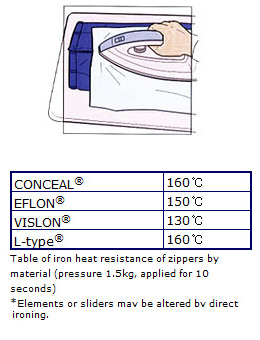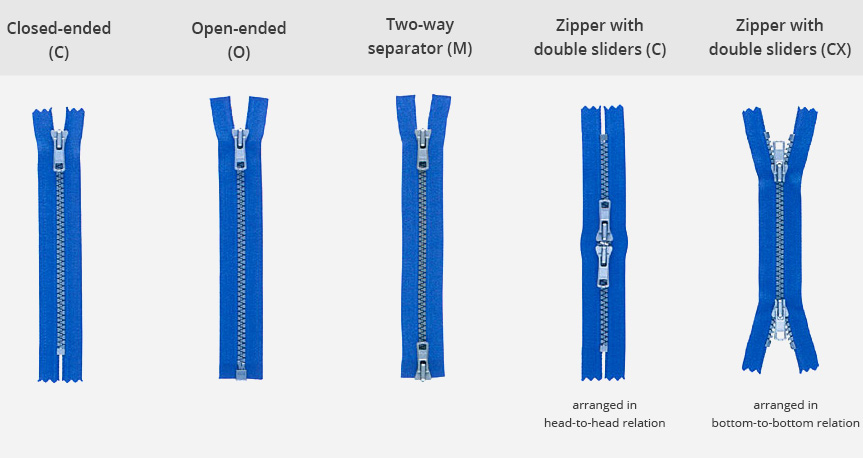As we know, a zip is not just a zip…
SLIDER
The slider joins or separates the elements when the zipper is opened or closed. Various types of sliders are available depending on use.
ELEMENTS
The teeth, also known as elements, are the parts on each side of a zipper that mesh, or engage, with each other when passed through the slider. When the left and the right side teeth are engaged they are called chain.
TAPE
The tape is manufactured exclusively for zippers. It is usually made of polyester, but depending on use, synthetic fiber tape, vinyl tape and cotton tape are also available.
Types of Functions
How to measure a zipper
CLASSIFICATIONS |
DIMENSIONS (A) |
DIMENSION OF TOP TAPE EXTENSION (B) |
DIMENSION OF BOTTOM TAPE EXTENSION (C) |
|---|---|---|---|
Closed-end zipper |
From the top end of the slider to the tip of the bottom stop |
From the top stop to the tip of notches of the cut end
|
From the top stop to the to the tip of notches of the cut end |
Zipper with double sliders (arranged in head to head relation) |
From the tip of one bottom stop to the tip of the other bottom stop |
From the upper bottom stop to the tip of notches of the cut end
|
From the tip of the bottom stop to the tip of notches of the cut end |
Zipper with double sliders (arranged in bottom-to- bottom relation) |
From the top end of one slider to the top end of the other slider |
From the top stop to the tip of notches of the cut end
|
Same as the top tape extention end portion |
Open-end zipper |
From the top end of the slider to the tip of the box |
From the top stop to the cut end
|
|
Two way separator From the top |
From the top end of the slider to the bottom end of the supplementary tape |
From the top stop to the cut end
|
|
Top open zipper |
From the top stop to the tip of the box |
From the top stop to the cut end
|
|
Reversible slider |
Rather than from the top end, measurement should be made from the shoulder inlet portion of the slider |
From the top stop to the cut end
|
|
When the top stop does not enter the slider |
Measurement should be made from the top stop |
From the top stop to the tip of notches of the cut end
|
Feeling inspired?
Check out William Gee’s fantastic range of YKK zips by clicking the link below, or call Debbie on 020 7254 2451 for assistance.
![]()
Using your zippers smartly
Unsmooth opening and closing of a slider
The gearing of the elements can be damaged by forcing a slider that does not open or close smoothly. Apply paraffin or the lubricating spray FastenerMate® to the front side and back of the elements and move the slider up and down several times to work in the lubricant and make the slider work smoothly.
 Loss of elements
Loss of elements
Trying to forcibly close the zipper of an overfilled bag will cause an excess load on the elements. This stress may cause the element to slip out from the tape. This is a fatal problem with a zipper, so the zipper should be closed only after bringing the two element’s sides near each other so that the slider can move more easily.
 Slider caught in cloth
Slider caught in cloth
The slider may catch on thread or cloth when opened or closed.
Attempting to free the slider by force will only worsen the problem.
Pull the slider back, removing the trapped thread or cloth. When the slider bites deeply into the cloth, do not force back but work back gently. When sewing zippers on garments, take care to avoid the possibility of the zipper getting caught.
 Putting on or removing clothing
Putting on or removing clothing
Clothing should be put on or taken off only after completely opening a zipper. When closing the zipper, the slider will move smoothly if the hook or the top button is fastened beforehand.
If the slider is left midway, excessive stress is placed on the elements, bottom stop or the slider itself, and may cause damage.
The same attention given to boots, gloves and accessories which have a zipper will keep problems to a minimum.
 Proper ironing with appropriate heat depending on the material
Proper ironing with appropriate heat depending on the material
Using the proper heat for the material being ironed is not limited to clothing but is also applicable to zippers. Zippers can be kept durable and beautiful by considering the material of which they are made and ironing with the proper heat. A zipper should always be closed, before ironing, the slider fixed in the proper position and the zipper coverd with a piece of cloth regardless of what material it is. The pull-tab of the slider should never be ironed when erect or on the reverse side.
![]()
Suitable method of cleaning
 A Zipper should be closed and the slider fixed before cleaning. Left open, the tip of the slider may damage the fabric or the tape may become stretched or may shrink. Strong alkaline detergents or chlorine bleaching agents used to remove oil or stains dissolve paraffin or oily film and must be used with care.
A Zipper should be closed and the slider fixed before cleaning. Left open, the tip of the slider may damage the fabric or the tape may become stretched or may shrink. Strong alkaline detergents or chlorine bleaching agents used to remove oil or stains dissolve paraffin or oily film and must be used with care.
![]()
The above article was taken from YKK’s helpful website. You can see more at ykkfastening.com.










.jpg)







 We’re thrilled to announce that we’ve partnered with Tree Nation, the platform to reforest the world & fight climate change! Home to over 90 planting projects in 33 countries, Tree Nation is a non-profit organisation that helps people & companies offset their CO2 emissions.
We’re thrilled to announce that we’ve partnered with Tree Nation, the platform to reforest the world & fight climate change! Home to over 90 planting projects in 33 countries, Tree Nation is a non-profit organisation that helps people & companies offset their CO2 emissions.